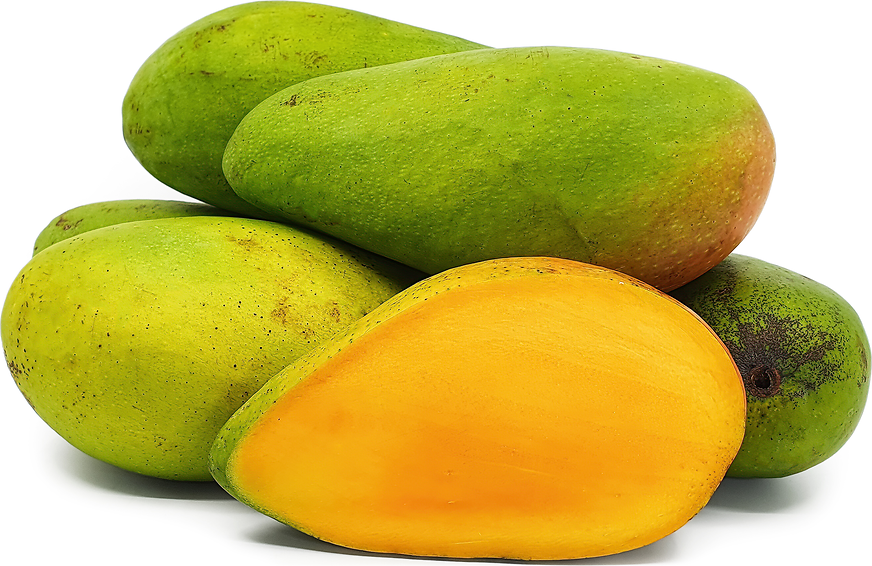


Arumanis Mangoes
Estimated Inventory, ea : 0
Description/Taste
Arumanis mangoes are palm-sized fruits, each weighing approximately one pound, and are generally smaller than more traditional mango varieties. Their elongated, elliptical shape is complemented by vibrant green skin speckled with light yellow dots. The fruit retains this green coloring even when ripe, making it ready to eat straight off the tree. Arumanis mangoes have a thick and tough exterior, serving as a protective layer for its soft, delicate flesh. This flesh boasts a bright golden yellow hue characterized by its smooth, juicy consistency and almost fibreless texture. The flesh encases a relatively small, oblong-shaped stone, giving the fruit a high flesh-to-seed ratio. Arumanis mangoes are known for their strong, sweet, tropical-scented aroma, resembling a blend of peaches, pineapples, and citrus. The flesh is edible raw and is sweet with a hint of tanginess.
Seasons/Availability
Arumanis mangoes are available from mid-summer to mid-fall.
Current Facts
Arumanis mangoes are botanically classified as Mangifera indica. A popular Indonesian mango variety, the Arumanis mango is also known as Harum Manis or ‘Harumanis.’ In Indonesian, the word ‘harum’ means “fragrant,” and ‘manis’ means “sweet.” The mangoes are said to live up to their name, making them a highly coveted fruit for culinary uses during their brief seasonal availability. These mangoes are extremely popular in Malaysia and are sold as a premium variety. In the past decade, Arumanis and other Indonesian mangoes have experienced a surge in popularity, emerging as major exports to China and Hong Kong. However, their limited seasonal availability and relatively short shelf life have restricted their ability to expand, localizing them primarily to Central and Southeast Asia.
Nutritional Value
Arumanis mangoes are rich in vitamins A, C, and B6, fiber, pectin, and folate. These nutrients support eye and immune health, act as antioxidants for skin and immunity, aid brain function and digestion, regulate cholesterol, and are crucial for fetal development in pregnancy. Arumanis mangoes are a source of potassium and magnesium, essential nutrients that support muscle and nerve function, help maintain healthy blood pressure and heart health, assist in controlling blood glucose levels, contribute to energy production, and promote bone health. The enzymes found in Arumanis mangoes can also help relieve digestive issues such as constipation and indigestion.
Applications
Arumanis mangoes are most often enjoyed raw and cut into slices. When young and green, they enhance savory recipes, while their ripe counterparts complement sweeter foods. These versatile mangoes can be used to prepare a wide range of dishes, including chutneys, jams, salsas, cakes, pastries, and sauces. They can also be transformed into mango juice or served as a dessert alongside sticky rice. Outside of its native Indonesia, this fruit is eaten in many Southeast Asian countries like Singapore and Malaysia. It pairs well with coconut, citrus, chilis, avocado, tamarind juice, mint, basil, jackfruit, and fish. Ripe Arumanis mangoes can be kept in the refrigerator for up to five days.
Ethnic/Cultural Info
Though mangos are originally from India, cultivation of the fruits in Indonesia dates back many centuries, and Arumanis mangoes have emerged as one of the most popular varieties. Arumanis mangoes originate from Probolingo, a city located in the East Java region of Indonesia, the country's primary mango-producing province. Java, home to Indonesia's capital, Jakarta, is the world's most populous island and the 12th largest globally. It has a rich history as the center of Hindu kingdoms and Dutch colonial rule, now holding a crucial role in Indonesia's economy and politics. In Indonesia, Arumanis mangoes are notably used to make rujak, an Indonesian fruit salad that combines these mangoes with an assortment of fruits and vegetables, all coated in a sweet and spicy sauce. Rujak is a customary dish served as a side and condiment at most meals, and it is one of the main elements used to complete the dining experience, adding complex flavorings.
Geography/History
Arumanis mangoes are native to Indonesia, primarily thriving in the provinces of East and West Java. They are also cultivated in some neighboring Southeast Asian countries, including Malaysia. These mangoes flourish in humid, tropical environments with abundant sunlight and consistent moisture. They are commercially grown and represent one of the key Indonesian mango varieties exported globally. Thanks to the growth of tourism and trade, Arumanis mangoes have gained widespread popularity in Southeast Asian countries such as Singapore, Japan, China, and Hong Kong. Indonesian agriculture departments and the government continuously work together to boost mango exports from Indonesia, which is expected to further enhance the popularity of Arumanis mangoes. You're most likely to encounter Arumanis mangoes in local markets and grocery stores across Southeast Asian countries during mango season.
Recipe Ideas
Recipes that include Arumanis Mangoes. One
| Indonesian Recipes |
|
Young Coconut Mango Pudding |
Podcasts

















